
By ERIC HURST
Scenario: A turbulent plume of black smoke rises over a major metropolitan area just as motorists begin their evening commute home. Traffic is snarled as mutual-aid fire apparatus from across the city slowly slalom their way to the scene. Community members and news outlets eagerly search for information on what’s happening, many of them turning to social media for answers. On Twitter, they’ll see photos and videos from eyewitnesses showing huge flames and a shadow-casting smoke plume, and they’ll listen to bystander comments, “What’s taking the fire department so long?” “Someone probably got killed in there!” “Why aren’t they spraying any water?” “Is that smoke toxic?”
If this incident happened in your district today, would your fire department have a timely, factual voice on social media? If the answer is no, someone, anyone, could be driving the narrative about what’s happening. When we talk about strategy and tactics in the fire service’s social media, photography and videography aren’t the first things that typically come to mind. That being said, these topics are also vital for fire departments to consider. Using social media in an honest and timely manner before, during, and after incidents is vital to strengthen our mutual reliance with the communities we serve.
RELATED
Eric Hurst on ‘Mastering Social Media and Photography’
Social Media: Tell Your Story; People Want to Hear It
The Fire Department and Social Media: What’s Your Policy?
Social Media: The Rules Are Already on the Books
The choice of strategy is easy for anyone with bunker gear to understand: offensive or defensive? In the offensive strategy, social media requires someone to proactively share incident information such as breaking news as it occurs. That individual, whom I’ll refer to as a “digital nozzle person,” or his designee is responsible for social media monitoring, which encompasses answering questions that come in and watching what other people are reporting about the situation for accuracy and to dispel rumors.
A defensive social media strategy is rooted in reactive engagement with the news media and community. Typically, the first interaction with a fire department representative will occur in a postcontrol or postincident time frame and is often in the form of a press release. By that time, eyewitnesses and reporters who were on the scene have already driven the narrative about what the fire department did or did not do. This strategy often results in firefighters wishing the community truly understood the hard work, risk, and positive outcomes to which they dedicate their lives.
Social media tactics of public safety agencies are widely debated and vary greatly. Those differences are often related to the “bleeding edge” of the public information we witness vs. the dated textbook methods that continue to be taught. Fewer than 10 years ago, many news outlets did not consider a social media statement from an official fire department account to be a verified, credible source. Today, the news media will not only take social media posts as hard truths, but they will also report an entire story based on 280 characters of text from a single, official “tweet.”
Social Media Platforms
In the wildland world, courses that teach new and experienced public information officers (PIOs) best practices only touch on social media and fail to teach video production. Meanwhile, when large wildfires occur, official social media accounts are created, and the PIO cadre creates daily videos. Name requests are made for PIOs with known video production experience, and sometimes, none of these individuals are available. When position requirements aren’t being taught but are expected on scene, that signals trouble.
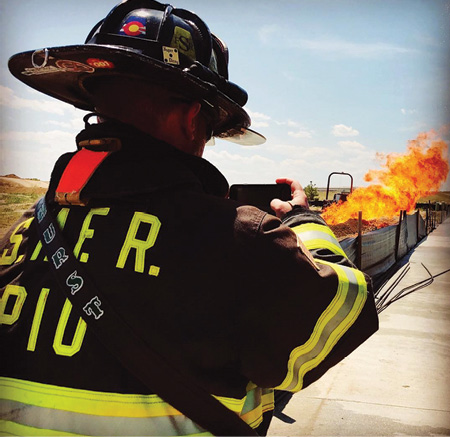
(1) Although a scene may not be safe to bring journalists into, fire department personnel can capture photos and videos of dangerous environments and use them to drive the narrative on social media. (Photos courtesy of South Metro Fire Rescue.)
The training disconnect isn’t limited to wildland; all branches of public safety are faced with similar dilemmas. The modern PIO is a journalist for his agency in every sense of the word, but basic PIO training doesn’t teach the necessary skills. For example, the legacy fire incident press release died on the steps of social media a decade ago, but its “ghost” haunts fire departments to this day. In today’s 24-hour social media news cycle, a press release should, quite literally, be the last thing a PIO does.
Chances are high that you have more social media accounts than your fire department, and that should raise some eyebrows. The first tactic is choosing what social media platforms your fire department needs. Pew research statistics in 2018 revealed that some of the most popular social media platforms may surprise you.
Number one is YouTube, with 73 percent of Americans watching videos there, and 94 percent of 18- to 24-year-olds searching for content. This demographic is a fire department’s target audience for recruitment, and viewers are undoubtedly watching videos about the agencies for which they may want to work—after all, YouTube is the world’s second largest search engine. If your department isn’t producing its own video content, search for it by name and see what other people are showing the world about your agency.
Number two is Facebook, with 68 percent usage by Americans. If that number isn’t already high enough, consider that one-half of Americans who don’t have a Facebook account live with someone who does. Most fire departments already have a Facebook page, and it shouldn’t be neglected. This platform provides a great place to share YouTube videos, photos, and more in-depth information about topics that your community should know about. Facebook allows more than 63,000 characters of text per post and 1,000 photographs per album, but don’t let those big numbers encourage you to share so much content that your audience eventually tires of it.
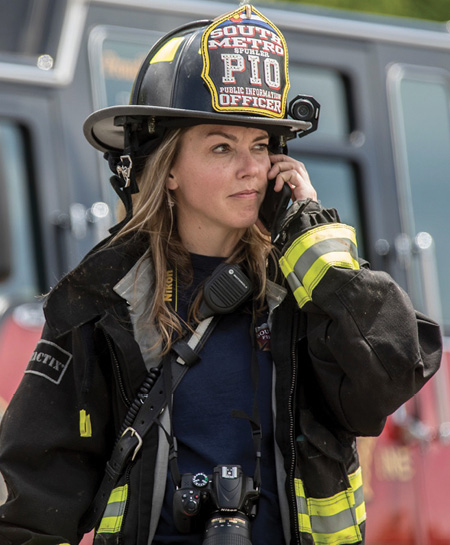
(2) Sometimes, you must use a smartphone as a phone while on scene. This public information officer (PIO) is operating in the offensive strategy and ready to capture important moments at a second’s notice. She is prepared with a helmet-mounted video camera rolling and a professional camera capable of capturing high-definition video and photographs within arm’s reach.
Number three is Instagram, with 35 percent of Americans visiting, searching for photos and short videos of their favorite subjects. Fire departments can share 10 photographs per post or videos 60 seconds or less in length. Hashtags are vital to your visibility on Instagram; using at least one hashtag results in 12.6 percent more engagement on that post. For example, using a broad hashtag like “#firefighting” will add the image to a pool of 435,000 images and make it more visible to thousands of people who follow that hashtag. Without a doubt, more hashtags are directly responsible for more followers.
Nextdoor© is an outlier and difficult to include in popularity statistics because its users are dependent on the population your fire district serves. The platform reports that 90 percent of U.S. neighborhoods are represented with varying numbers of active users. A rural fire district may not have a big audience on Nextdoor, but an urban or a suburban fire agency likely does. For example, consider South Metro Fire Rescue (SMFR) in Colorado. With an audience of more than 174,000 residents, this social media platform has a larger subscriber audience than all of SMFR’s others combined.
Number seven is Twitter. News lives on Twitter 24/7/365, making it the most popular social media destination for PIOs, journalists, and community members. For most fire departments operating in the social media offensive strategy, Twitter is the first place (maybe the only place) departments will post breaking news information. Unlike the previously mentioned platforms, Twitter is drastically limited in character count and image/video sharing. A 280-character limit means the digital nozzle person might have to get creative with wording, but he also better make sure the wording is correct. Once you send a “tweet,” it cannot be edited. Meanwhile, posts on YouTube, Facebook, Instagram, and Nextdoor allow for editing if an error occurs.
Twitter also allows users to share four photographs or 45 seconds of video per message, and, boy, are those visuals important! Brandwatch.com reports that an individual tweet is 150 percent more likely to be shared if it has a photo or video attached. The “solid 45” and “5 × 9” methods are your best tactical choices for video. The solid 45 is best used when action abounds and 45 seconds of the same scene isn’t too boring. Social media audiences want to see more—not feel like they’ve seen enough. The 5 × 9 method is best for telling a more dynamic story about the scene by capturing five separate nine-second clips, then joining them together in a video app before posting the final 45-second movie to your tweet. If your scene is a mere “can job” but it still deserves a tweet, meet somewhere in the middle between nine and 45 seconds of video to help tell the story or post a few still photos.
Rules for PIOs
PIOs must follow a few hardline rules when capturing images. First, they can share only photos and videos that they capture in public view unless property owners give consent for the images to be shared. If there is any reasonable expectation of privacy where the images are captured—i.e., inside a private residence or on private property, beyond the view from the nearest public road or walkway—PIOs should use those images only with permission.
Second, abide by the Health Insurance Portability and Accountability Act and maintain patient privacy at all cost. The digital nozzle person should download a “blur” app to his smartphone and be ready to conceal license plates, tail numbers, faces, or anything that could identify a patient.
The third photography/videography rule to follow includes safety, policy, and reputation, which are all closely tied. Do not publicly share images of unsafe behaviors, which can be as simple as firefighters not wearing appropriate personal protective equipment for the situation. Also, do not publicly share any image that violates internal departmental policy unless there is an overwhelmingly positive reason to do so and command staff has approved it. Avoid sharing any photo or video that could tarnish the fire department’s reputation. For example, laughing isn’t unsafe or a policy violation, but capturing laughing firefighters in front of a burned-out home could be a reputation breaker.
When it’s time to break news on Twitter, the first message should include a visual. Many fire departments use PulsePoint© to take a screenshot of the response map from the app and use it in the initial tweet. This is a creative way to steer new users into downloading PulsePoint while providing an ever-important image to increase views and retweets. The first tweet should verify that the incident is occurring and include any pertinent information from which the community and news media would benefit. Once on scene, the updates should include video or photos of the incident that adhere to the rules previously mentioned. Journalists and community members care most about the “Big Three”: incident status, injuries, and cause. Assuming the following is true, simply stating that the fire is under control, no one was injured, and the cause is under investigation should help put minds at ease.
Once the incident is under control, the digital nozzle person has a perfect opportunity to share relevant safety messages with his social media audience. If a working smoke alarm wakes up a sleeping family and alerts them to a fire, stating that smoke alarms save lives makes sense. One could go even further and suggest that everyone test their alarms to make sure they’ll work in the event of a fire in their home. Although the subject is timely, including themes like “close before you doze” or the importance of home fire drills may be well received by concerned community members.
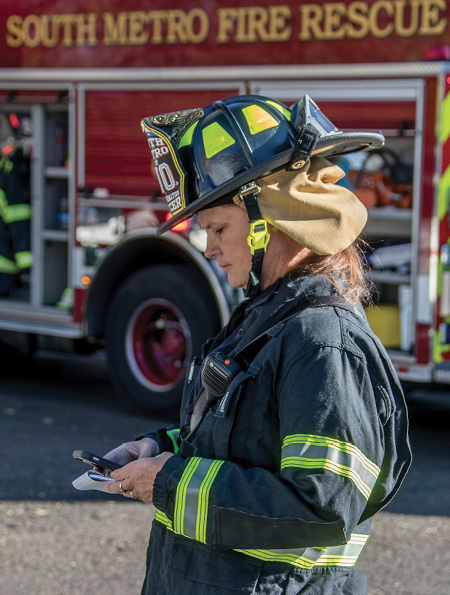
(3) PIOs need to gather the facts, organize their thoughts, and craft those thoughts into a clear social media message. Monitoring the account for questions, comments, and concerns must occur continually throughout the incident. Remember, social media is interactive.
Like Instagram, hashtags are also important on Twitter because they increase the number of viewers your tweet receives and help index the subject matter for people searching it. During a major incident, the best tactic is to hashtag the fire or command name and state that it will be used for information pertaining to the scene. However, a word of caution: Search Twitter for your unique hashtag idea before using it! The digital nozzle person will assume the unnecessary risk of being hit by a social media “hammer” if he hashtags something that could be considered offensive, that already represents an unfavorable topic, or that has been used to discuss a separate incident.
For example, a major fire burning a business named Guitar Strings may have already happened somewhere else in the past, and “#GuitarStringsFire” has already been used. With different images and information already associated with that hashtag, it’s best to use something different. The big fire might not be the only story of the night if the department uses “#GStringsOnFire” to index the incident on Twitter. It’s always best to check and recheck for misspellings and potentially inappropriate content before publishing a post.
You can post breaking news about an incident on any social media platforms your fire department chooses, but consider the audience in your area before deciding where to focus your time. Also remember that social media is interactive; if the fire department posts information, it will likely receive questions, comments, or concerns about what is happening. Social media monitoring is a job function that must be filled, and if the digital nozzle person is too task-saturated to check back on numerous accounts, he should limit where he posts information. In most media markets, Twitter is the best place to post on incidents and updates.
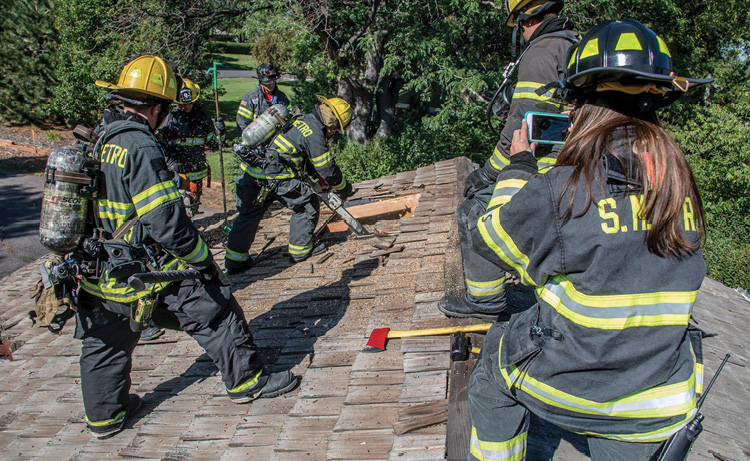
(4) This PIO is using the 5 × 9 method to capture recruit academy vertical ventilation training at an acquired structure. The video can be edited and posted to social media quickly, allowing plenty of time to capture higher-quality video and photos before the action is over.
PIO Social Media “Judgment Tools”
Using a set of ideas or “tools” to help judge a situation can aid any PIO in making the right call on social media decisions. The “20-1-2” judgment tool can help a PIO or digital nozzle person decide how many platforms on which to post breaking news and when to phone a friend for help. If an incident will be controlled in 20 minutes, updates to Twitter should be sufficient. If an incident won’t be under control for up to one hour, there is a larger impact to the community and, thus, more interest from citizens and news media. This should trigger a call or text to a trusted friend in public safety to assist you with social media monitoring. This person doesn’t necessarily need access to your official accounts; he just needs to read the comments and watch what the news is reporting about the incident. If the social media monitor sees inaccurate information, questions that haven’t been answered, or rumors swirling, he should contact the lead person on scene and give him the proactive advantage.
The one-hour marker during an incident should also signal a need for more social media outreach. After Twitter, Nextdoor or Facebook should be the next platform to share information. Nextdoor allows a fire department to send a 110-character “urgent alert” that will get the attention of area residents by push notification, text message, or e-mail. You can post a longer message containing images or video to Nextdoor and Facebook to further advise and reassure more citizens. If it hasn’t already been done, the “one-hour-until-under-control” estimate should also trigger the need to establish a media staging area and a hashtag for the incident.
The “2“ in the judgment tool represents a second operational period. In those rare instances where a major incident will last 12 hours or longer, phoning a friend at the one-hour mark should turn into a request for more on-site or virtual social media help. Incidents of this magnitude often result in road closures, evacuation notices, and visuals that trigger the highest level of community and news interest. Although on-camera television interviews and press conferences are a top priority, do not neglect the people interacting on social media.
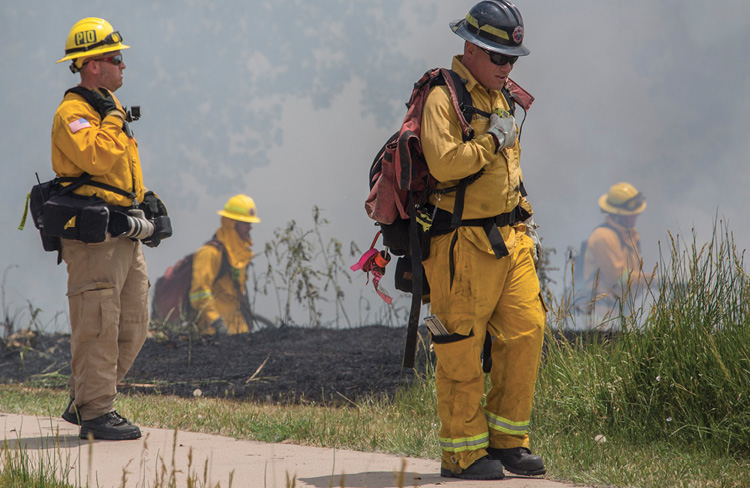
(5) Be where the action is while being safe. A PIO with his feet cemented at a street corner command post is most certainly missing opportunities to capture the real story and share it. The offensive social media strategy requires the same mindset as an embedded battleground photographer.
The smartphone is a fantastic digital “Swiss army knife.” Although its camera is more than sufficient, it can’t capture images when sending text messages, creating social media updates, and making phone calls. The tactically savvy digital nozzle person should consider adding static video cameras to his arsenal of devices. Allowing a body, dash, helmet, or other stationary video camera to record the scene will undoubtedly benefit many people at the incident’s conclusion. Raw video from the scene might be worthy to share with the community and journalists on social media to help tell your story. It may also serve as evidence for investigators and game tape for training reviews after the incident. Those power-on and go-action cameras ease the task saturation that the modern fire service PIO faces.
In the offensive strategy, social media means taking your fire department’s digital identity to the next level, one that forces many people out of their comfort zones. However, it’s one that our communities and news media partners have come to want and, in some cases, expect. The fire service is a 24-hour operation, with our personnel doing truly amazing things on a regular basis. Sharing their stories in real time while informing and educating the people who rely on us should be a top priority.
ERIC HURST is a 21-year fire service veteran and a public information officer with South Metro Fire Rescue in Centennial, Colorado. He is also an internationally published photographer and videographer.

